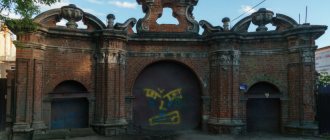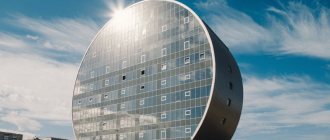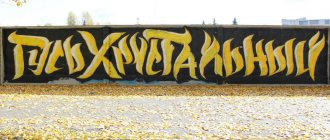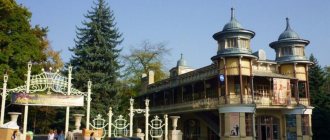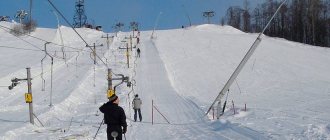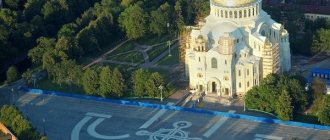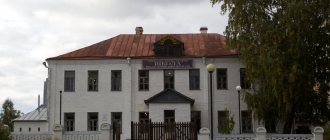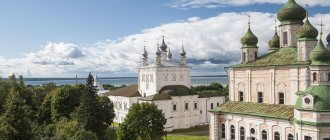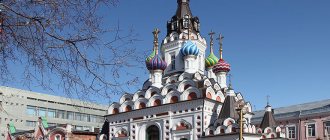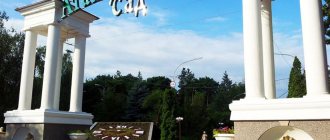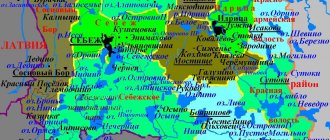Temples and chapels of Naro-Fominsk
St. Nicholas Church
- Address: General Efremov, 2.
Until 1812, instead of the current parish, there was a wooden St. Nicholas Church and, according to legend, Napoleon Bonaparte himself stayed overnight there during the Patriotic War. During the retreat, the French burned the temple.
In 1845, construction began on a new, more durable sacred structure, designed by the architect Burenin. Funds for construction were allocated by local landowners – Skuratov and Lukin. The first parishioners were received in the renovated church in 1852; at that time it was one of the most beautiful in Russia.
St. Nicholas Church has a rich history: after the revolution, it was first turned into a guardianship for the poor, then into an almshouse, then closed completely, and during the war years it was mercilessly looted. In the post-war period, it first became a warehouse, and later - the historical museum of Naro-Fominsk. In 1989, they decided to return it to believers. Thus began a restoration that lasted until 2004.
Now the Church of St. Nicholas lives a full-fledged Orthodox life: services and sacred rites are held there, and Sunday schools are open for parishioners of all ages. It possesses such shrines as particles of the relics of the great martyrs, ancient icons, and arks.
Chapel of Our Lady of the Unquenchable Lamp
- Address - pl. Victory, 1.
The “Unquenchable Lamp” chapel appeared in Naro-Fominsk in 1990 - as a repository of the Eternal Flame in memory of the fierce battles that took place at this place in 1942 for the defense of Moscow . It fits organically into the composition of St. Nicholas Church and, along with it, is an important landmark of Naro-Fominsk.
Temple of New Martyrs and Confessors
- Address: Shibankova microdistrict.
In the north of Naro-Fominsk there is also an Orthodox parish - small, but very interesting. It cannot boast of much history, since it was erected in 2016. It has only one dome - gilded, with a cross. The facade of the building is whitewashed, the roof is dark. The cathedral is surrounded by a beautiful park of trees, apparently planted a long time ago.
Content
- 1 Epiphany Church (Vereya)
- 2 Ascension Church (Burtsevo)
- 3 Temple of the Entrance to Jerusalem (Vereya)
- 4 Demetrius-Thessaloniki Temple (Dubrovo)
- 5 Elias Church (Aprelevka)
- 6 Elijah Temple (Vereya)
- 7 St. John the Baptist Church (Afineevo)
- 8 Church of Constantine and Helena (Vereya)
- 9 St. Nicholas Cathedral (Naro-Fominsk)
- 10 St. Nicholas Church (Ateptsevo)
- 11 St. Nicholas Church (Kamenskoye)
- 12 Church of the Intercession (Petrovskoe)
- 13 Church of the Intercession (Tashirovo)
- 14 Church of the Transfiguration of the Lord (Spas-Kositsy)
- 15 Transfiguration Church (Slepushkino)
- 16 Seraphim Temple (Selyatino)
- 17 St. Sergius Church (Mogutovo)
- 18 Trinity Church (Martemyanovo)
Museum attractions
Museum of History and Local Lore
- Address – Zhukova, 8.
On May 9, 1973, on Victory Day, the official opening of the Naro-Fominsk Historical and Local History Museum took place, moved to another building. Previously, it was located within the walls of the Church of St. Nicholas the Wonderworker.
Today its museum collection consists of more than 25,000 exhibits. Everything is collected here: the ethnography of the region, and the history of the existence of Naro-Fominsk. The exhibition is located on two floors.
The first one contains everything related to the history of the town and the place where it is located. And on the second, visitors can see an exhibition of works by animal artist V.V. Andriyashina are very interesting naturalistic figures of animals, made in life size from paper and plaster.
The museum constantly hosts exhibitions dedicated to the valiant glory of the city, the history of the world-famous record plant located nearby, and the famous residents of Naro-Fominsk.
Elijah Temple (Vereya)[edit]
Elijah Temple
built in 1711 on the site of dilapidated wooden churches of the 17th-18th centuries.
The current temple is brick, four-pillared with five domes, with a small refectory and a three-tiered bell tower. The temple was equipped with rich iconostases and icons, and there were fresco paintings on the walls. In the 30s it was closed, icons and church utensils were requisitioned, and the building was used for economic purposes.
In the post-war period (1947-1948), the temple was again restored by parishioners, equipped with icons, and has been in operation ever since.
Address:
Moscow region, Naro-Fominsk district, Vereya, Kustarny lane, no. 4.
Telephone:
+7 (496) 346-76-88
Monuments and memorials
Monument "Tank T-34"
- Address - pl. Victory, 1.
Hapo-Fominsk is a city of military glory. The battles near Nara belong to the category of those whose memory will live for centuries.
In the fall of 1941, it was here that the Red Army stopped the advance of the German army. The feat of G.G. has gone down in history. Khetagurov, who destroyed the enemy headquarters on a KV-1 tank, causing irreparable damage to the enemy. There is a version that the T-34 Tank stands exactly on the spot where this event took place.
The T-34 Tank serves as a reminder of the power of our weapons and the valor of the Soviet people during the war.
Monument to M.G. Efremov
- Address - pl. Victory, 1.
Lieutenant General Mikhail Grigorievich Efremov - commander during the Civil War. During the Second World War, he was the commander of the 33rd Army, which defended the approaches to the capital Moscow near Naro-Fominsk.
In the spring of 1942, the Germans surrounded the army. In order not to be captured, three times wounded Efremov decided to shoot himself. At the same time, his entire staff committed suicide. The invaders did not take anyone from the 33rd Army prisoner voluntarily - this is what German archive sources say.
Protiney, having captured the line, paid tribute to the worthy enemy by burying the lieutenant general with honor near the village of Slobodka. Efremov was awarded the title of Hero of the Russian Federation in 1990.
Stella "City of Military Glory"
- Address: Victory Square.
Hapo-Fominsk became the “City of Military Glory” in 1990, and a year later a commemorative stele with the coat of arms of Russia 12 m high was erected on the main city square. At the foot of the monument there are three tables: one with a literal presidential decree conferring the honorary title on the city, another with a description of the feat of Naro-Fominsk during the Second World War, the third contains tragic figures for the number of victims and destruction that the region suffered during the war.
Monument "Black Tulip"
- The address is a square on Lenin Street.
“Black Tulip” is a memorable tribute to the valiant internationalist soldiers who gave their lives in the line of duty in Afghanistan. The opening of this memorial took place in 1991.
All honors for soldiers who fought in Afghanistan take place near this sad memorial. The memory of those who did not return from the Afghan war is also honored here. In the Narofominsk region, almost 400 people served in Afghanistan, 23 of them were unable to return alive.
The monument is located in Memory Square. Next to it there are memorial plaques with a list of dead residents of Naro-Fominsk who took part in other local clashes and conflicts.
Epiphany Church (Vereya)[edit]
Epiphany Church
built in 1777 at the expense of the Verei merchant M.E. Sedelnikov in the Baroque style, on the site of a dismantled wooden church. In 1782, a brick bell tower was added to the temple.
The temple is an example of church architecture of the last quarter of the 18th century. In 1967-1969, under the leadership of the architect-restorer N.N. Sveshnikov, restoration work was carried out, in 2007 the temple was updated and landscaped.
In the 1930s, Alexy Serebrennikov served as a psalm-reader in the church; in 1937, he was arrested and executed by the NKVD troika. He was buried in an unknown common grave at the Butovo training ground near Moscow, and is now glorified as one of the holy new martyrs.
Address:
Moscow region, Naro-Fominsk district, Vereya city, st. January 19, no. 2.
Decoration sculptures in Naro-Fominsk
"Hearts of Lovers"
- Address – Zhukova, 12.
The composition “Hearts of Lovers” was created by sculptor V.F. Mitroshina. It decorates the square near the Wedding Palace and is made in the form of an arch of two hearts, under which two lovers walk towards family happiness.
Today it is a traditional place for newlyweds, who at the end of the wedding ceremony symbolically pass under this arch. “Hearts of Lovers” is the most romantic monument in Naro-Fominsk and one of its highlights.
"Emelya on the stove"
- Address: Marshala Zhukova, 6.
This sculpture appeared in Naro-Fominsk in 2008 and immediately won the love of townspeople and visitors. It is believed that it is dedicated to travelers. The fairy-tale character Emelya, with an umbrella in his hand and a suitcase at the ready, sits on a stove resting on wheels from four types of transport - from a cart, from a car, from a motorcycle and from an airplane, which symbolize the evolution of means of transportation.
Pike also plays an important role in this funny composition. There is an opinion that your cherished wish will come true if you entrust it to this fish. The main thing is not to forget to say the famous saying from a Russian folk tale.
The author of the sculpture is the monumental artist, blacksmith G.V. Novoselov. “Emelya on the stove” is not his only creation in Naro-Fominsk. He is also the author of the “Black Tulip”, a monument to fallen soldiers while serving in Afghanistan, and the forged doors in St. Nicholas Church. But “Emelya on the Stove” is unique in that there is not a single separately cast element in this sculpture.
Church of Constantine and Helena (Vereya)[edit]
Church of Constantine and Helena
built in 1784 at the expense of the merchants Zanegin, instead of a wooden church of the 17th century.
Baroque traditions in the layout of volumes are combined with simple and strict architectural decoration of facades in the style of early classicism. Before the revolution, the temple had rich decoration and ancient icons donated by generations of local merchants. Almost all icons, both local tiers, iconostasis, and placed in separate icon cases, had silver gilded decorations. In the temple there were liturgical books of the 18th century, as well as an altar gospel in a frame with silver details, dated 1654. The belfry on the bell tower consisted of 8 bells, the weight of the largest was 164 pounds, and the smallest - 1 pounds.
Address:
Moscow region, Naro-Fominsk district, Vereya, st. Kirovskaya, 46/28.
Parks and squares of Naro-Fominsk
Vorovsky Park
The main park of Naro-Fominsk is located on a historical site. The estate of the princes Shcherbatovs, which was called “Nara,” was once located here. The square was an integral part of it. The estate itself burned down at the beginning of the 20th century, leaving no photographs of itself.
The only thing left of its former luxury is this park with its magnificent linden alleys. After the revolution, he received the name of Vaclav Vorovsky, a comrade-in-arms of V.I. Lenin. Now it is the city's Central Park of Culture and Recreation and a place of attraction for citizens. All public holiday celebrations, cultural and sporting events are held here.
In 1941, there were such fierce battles with the Germans advancing on Moscow that after the war the park had to be restored within 10 years.
In the park there is the “Walk of Glory of Heroes”, inaugurated on December 24, 2014. The place was not chosen by chance: here in 1979 a memorial complex appeared in memory of the soldiers who died in battles for their Motherland during the war. It is in the park area that the largest burial place of Soviet soldiers within the city is located.
Shady alleys make Vorovsky Park convenient for walking, and sports fans can rent sports equipment and take care of their health at the sports complex located here or kick a ball on the football field. On weekends there is a shooting range, children's and sports trampolines, and a ropes course. There is a playground for children next to the sports complex.
Victory Park
- Address – Profsoyuznaya, 41.
Victory Park is located on the very bank of the Nara River. In its central part there is a Monument to the fallen pilots during the Second World War in the form of an airplane soaring into the air. There is a fountain next to it. The picturesque and cozy place is a favorite walking place for many tourists and residents of Naro-Fominsk.
Bobruisk public garden
- Address – Kalinina, 8a.
The square is so called in honor of Bobruisk, the sister city of Naro-Fominsk, and “square” because there are many children’s playgrounds, slides and cute fairy-tale sculptures made of wood, which create a special atmosphere of childhood. At the entrance, visitors are greeted by a funny beaver cast in bronze. Those interested can sit next to him on a bench and take great photos.
Yolochki Forest Park
Another place worth visiting in Naro-Fominsk. True, visits here are made mostly by city residents, not visitors. The forest park is located in the southern part of the village, behind the railway tracks.
It’s just wonderful to walk there during the day with children, as reviews say, but in the evening there’s nothing to do here - there’s no lighting or any equipment. But there are a lot of squirrels here that you can feed practically from your hands. In winter, you can go skiing in Yolochki - there is a track, and there are also bicycle trails for cycling enthusiasts. But again, the equipment of leisure facilities leaves much to be desired.
Temple of the Entrance to Jerusalem (Vereya)[edit]
Temple of the Entrance to Jerusalem
built in 1667 on the high picturesque bank of the Protva River, under Patriarch Joachim. Initially it had the status of a cathedral of the Spassky Monastery.
The temple is a monument of federal significance and is one of the oldest buildings in the Moscow region. It can be attributed to the classic works of its time - a quadrangular building (chetverik) with five domes on solid drums. The domes, covered with wooden ploughshares during restoration in 1960, were dismantled in the 21st century and replaced with copper sheets, as well as the covering of the roof, three apses and the belfry. The upper part of the facades is decorated with a number of false zakomaras and arcature belts. An octagonal hipped bell tower adjoins the temple from the northwestern corner. It is the tent that makes it extremely recognizable and undoubtedly dates back to the 17th century.
Address:
Moscow region, Naro-Fominsk district, Vereya, st. Lesnaya, p. 3.
Other interesting places in Naro-Fominsk
Panel "Lenin and people"
- Address: Marshal Zhukova, 2.
This panel is located on the building where the Silk Mill was once located. It is a historical and artistic value of Naro-Fominsk. The building itself, erected in 1840, is already an architectural monument, and its historical value lies in the fact that the paper mill located in it is directly related to the development of the town.
It was the Silk Mill that caused the unification of the villages of Nara and Fominskoye and the formation of a city here. The founder of the paper spinning manufactory (as the plant was called at that time) was D.P. Skuratov. Then the factory began to actively develop and produce a huge number of rolls of various fabrics. It was also the historical center of Naro-Fominsk, from which the construction of the first microdistricts began.
In 1971, the plant received a state award for its success in fabric production and the use of new technologies. However, the Silk Mill ceased its activities as a result of the collapse of the USSR. Now this art object is one of the main attractions of Naro-Fominsk.
Alley of Hero Cities
- Address: Victory Square, 1.
The Alley of Hero Cities was opened in Naro-Fominsk as part of the All-Union Memory Watch on May 3, 1979 and stretched from the fence of the Church of St. Nicholas the Wonderworker to Victory Square. It is dedicated to the exploits of hero cities, the names of which are inscribed on cast-iron grates built into the ground around the trunks of birch trees, of which the alley itself consists.
Nara River
The Nara originates in Lake Poletskoye and flows into the Oka. It was described and included with all its tributaries into a general map by order of Tsar Ivan the Terrible in the 16th century.
Nara is famous among fishermen for the mass of fish and the wealth of its various species. Here you can catch crucian carp, pike, perch, ide, burbot and many other fish species. In the upper reaches, artificial fish farming is practiced.
The nature around Nara is extremely picturesque and is an attractive place for family holidays, as evidenced by numerous reviews.
Historical facts
- 1339 - the first documentary mention of the village of Fominskoye, which arose on the Nara River.
- 1654 - by decree of the tsar, the village was assigned to the Zvenigorod Savvino-Storozhevsky monastery.
- October 1812 - Napoleon’s retreating army passes through the village of Fominskoye.
- 1840 - foundation of a paper spinning factory, which would later become a city-forming enterprise.
- 1864 - unification of the villages of Fominskoye and Malaya Nara.
- 1892 - construction of a new weaving factory building, emergence of a workers' settlement.
- 1918 - the village of Naro-Fominskoye becomes the center of the district of the same name.
- 1926 - the workers' settlement receives city status.
- November-December 1941 - fierce fighting takes place in the city. More than 680 buildings were destroyed, including a weaving factory.
- 2009 - the city was awarded the honorary title “City of Military Glory”.
What to visit in the vicinity of Naro-Fominsk
Tubing park Elagino
This entertainment complex is located in the village of Elagino, 10 km south of Naro-Fominsk. Wonderful conditions have been created here for a ski holiday in the Moscow region. The trails are equipped with the latest technology, and the staff is always ready to help if necessary.
The territory of the tubing park is very huge, you can stay there all day, because in addition to active recreation, you will also be offered passive recreation - sit in a warm cafe, warm up with a cup of coffee and eat delicious kebab. Children from 5 years old will simply be delighted with this attraction.
Zosimova Pustyn Convent
27 km east of Naro-Fominsk is the village of Zosimova Pustyn, where the Trinity-Odigitrievsky stauropegic convent of the same name is located. This Orthodox monastery was founded back in 1826 by the monk Zosima.
Like many other shrines in Russia, during the Soviet period it was not used for its intended purpose - both a pioneer camp and an agricultural artel were located here.
It was returned to the Orthodox Church in 1999, and in 2000 it received the official status of a monastery. The main monastery churches are the Trinity Cathedral and the Church of John the Baptist. And not far away you can find the mass grave of pilots.
Wake Park Wannawake Park
In the small village of Shapkino, 27 km west of Naro-Fominsk, there is another interesting place for active leisure - the first area Wake Park, located next to small reservoirs. From the reviews it becomes clear that this place is far from ideal, there is still a lot of work to be done here, but overall the feedback is positive. Many people note that the winch in Wannawake Park is very decent, they say, there is a good place where you can go for the weekend. And the conditions here are decent for fishing.
Church of the Ascension (Burtsevo)[edit]
Ascension Church
built in 1730 by the owner of the village M.S. Anichkov, on the site of a dilapidated wooden Tikhvin church, built in the early 18th century.
The two-story brick building of the temple has a unique composition, in which the arms of the cross are equal in height to the central volume, the technique of arranging small chapters in the cardinal directions, and the extreme laconicism of the decorative decoration develop the artistic principles inherent in the architecture of the Great Cathedral of the Donskoy Monastery in Moscow. In 1788, the temple was repaired, adding a third tier of bell tower with a spire.
Address:
Moscow region, Naro-Fominsk district, Burtsevo village, 120.
Telephone:
+7 (496)342-70-74
Seraphim Temple (Selyatino)[edit]
Seraphim Temple
built in 2014 on the initiative of local residents who united into an Orthodox parish in 1998.
In the young village of Selyatino there was no church before. The administration of the urban settlement allocated a plot of land for the construction of an Orthodox church. The dean of the churches of the Naro-Fominsk district, Priest Georgy Ashkov, consecrated the first stone that was laid in the foundation of the future church. The parishioners built a small chapel in honor of the icon of the Most Holy Theotokos of Tenderness, where they celebrated the first liturgy on February 9, 2000.
Construction of the main temple began in 2004. In 2010, the crosses were consecrated and after the service they decorated the five domes of the temple. In 2013, work was carried out on the interior decoration of the temple and the construction of portals for the main entrances.
Address:
Moscow region, Naro-Fominsk district, pos. Selyatino, st. Sportivnaya, 1.
Telephone:
+7 (495) 428 06 54
St. Nicholas Church (Kamenskoye)[edit]
St. Nicholas Church
built in 1312. It is one of the oldest surviving churches in the Moscow region, as well as one of the first stone churches built in the Moscow principality.
The single-domed, three-apse temple is built entirely of white stone, with most of the blocks processed using a “semi-clean” technique, only the details of the portal, plinth, and archivolts of the zakomara are smoothly hewn. Each side of the quadrangle is only 10.2 meters.
Structurally, the St. Nicholas Church belongs to the rare “pylon” type in Russian architecture or the type of “temples with corner pillars”, which became widespread mainly in South Slavic countries in the 12th-14th centuries. These were pillarless temples, in which protrusions - supports - were made in the corners to distribute the load from the light drum and dome. Because of this, the internal space of the temple in plan took the shape of a cross.
Address:
Moscow region, Naro-Fominsk district, Kamenskoye village.
Sergius Church (Mogutovo)[edit]
Sergievsky Temple
built in 1693 by boyar P.A. Lopukhin on the shore of a picturesque pond.
The temple building with a multi-tiered central part is an example of the Moscow (Naryshkin) baroque.
After the revolution, the temple was closed. During the war there was a hospital there. For the next decades it stood empty. At the end of the 1950s, the bell tower was dismantled. Subsequently, the south-eastern part of the altar was destroyed. Over time, the wooden roof over the refectory became dilapidated and collapsed. By the beginning of the restoration, only the walls remained of the refectory.
The restoration of the temple began in the fall of 2001, and now almost all restoration work has been completed. Worship services resumed in May 2001.
The temple is an architectural monument of federal significance.
Address:
Moscow region, Naro-Fominsk district, village. Mogutovo, p/o Afanasovka.
Present day
By the end of the first decade of the new century, the city began to come to life. Today this is the new Naro-Fominsk where there is a meat processing plant and a dairy plant. Also working successfully here:
- Naro-Fominsk house-building plant;
- knitting factory;
- Keralite LLC;
- Ball Beverage Packaging Naro-Fominsk LLC;
- Naro-Fominsk Machine-Building Plant;
- Naro-Fominsk plastics plant.
With the advent of jobs, the dynamics of the population decline stopped at around 62 thousand people.
Naro-Fominsk is being improved, new residential areas are being built.
The city is connected to Moscow by regular bus routes served by comfortable cars. The capital can also be reached by high-speed trains.
Intercession Church (Petrovskoye)[edit]
Intercession Church
built in 1858 by Prince A.V. Meshchersky. It is a chapel to the bell tower of the Church of St. Peter, Metropolitan of Moscow. Since the construction of the temple, services in winter have been performed in it.
After the closure of the Zosimova Odigitrievskaya Hermitage, the Monk Afanasia (Lepeshkina) - the abbess of the monastery - and her novice Varvara prayed here before her arrest. After the destruction of the Church of St. Peter in the 30s of the 20th century and the closure of almost all the churches in the area, the Intercession Church became the center of spiritual life for several generations of Narofominsk residents and residents of surrounding villages.
Address:
Moscow region, Naro-Fominsk district, Petrovskoye village.
Telephone:
+7 (496) 342-90-76
